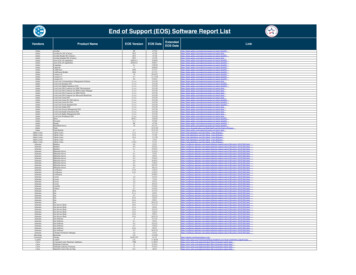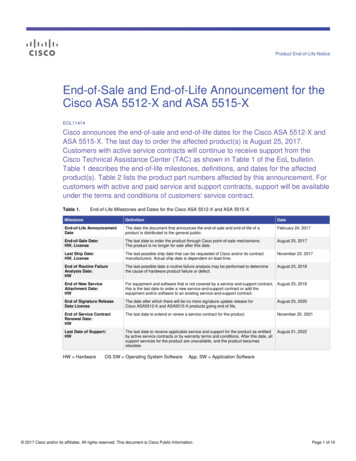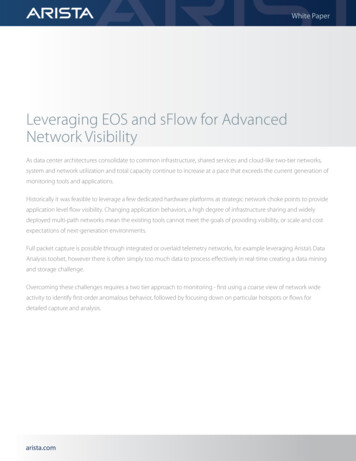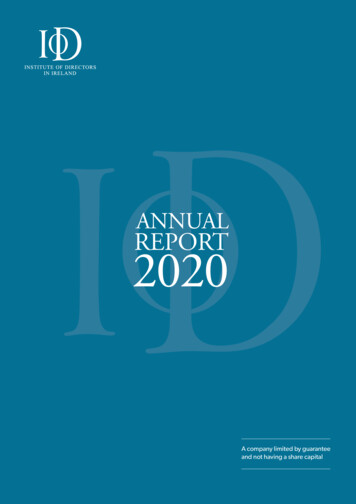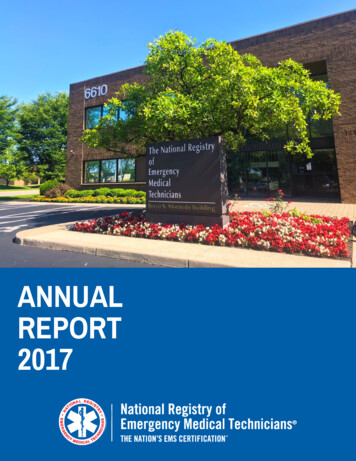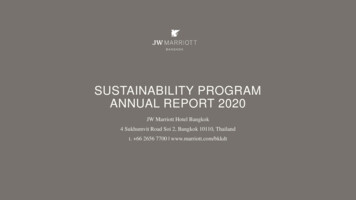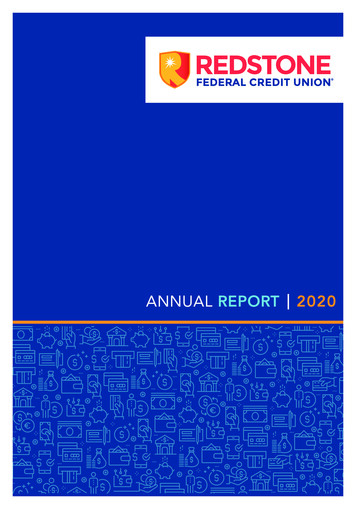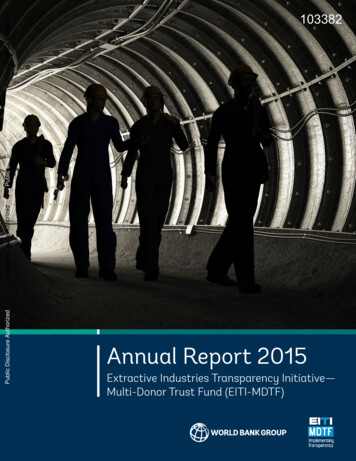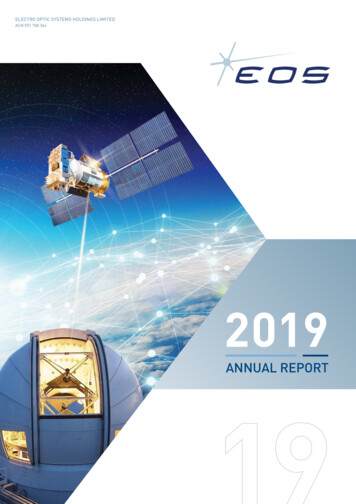
Transcription
eLectro optic systeMs HoLDinGs LiMiteDacn 092 708 3642019annuaL report
contents1Review of Operations5Directors’ Report20Auditors’ Report27Directors’ Declaration28Consolidated Statement of Profit or Loss andOther Comprehensive Income29Consolidated Statement of Financial Position31Consolidated Statement of Changes in Equity33Consolidated Statement of Cash Flows34Notes to and forming part of the Financial Statements99ASX Additional Information100 Twenty Largest Ordinary Shareholders
review of operations1. RESULTS FOR FULL‑YEAR ENDED 31 DECEMBER 2019The consolidated entity (“EOS”) reported an operating profit after income tax of 18,058,758 for the twelve monthperiod to 31 December 2019 [31 December 2018: 15,081,372] based on revenues from ordinary activities totalling 165,985,563 [31 December 2018: 87,130,396].The consolidated entity reported net cash used by operations for the twelve month period totalling 33,829,630[31 December 2018: 15,686,202]. At 31 December 2019, the consolidated entity held cash totalling 77,881,766[31 December 2018: 40,538,225]. Cash of 102,025 [31 December 2018: 119,025] is restricted as it secures bankguarantees on premises.The profit after tax was based on EBIT of 22,354,491 and tax expense of 3,911,516. Foreign exchange movements didnot make a substantial contribution to this result.The full year EBIT of 22,354,491 [31 December 2018: 15,118,275] is a substantial improvement over the correspondingprior period and exceeds prior guidance of 20 million.These financial results are in line with management expectations. The individual sector performances are furtherdiscussed below.2. DEFENCE SYSTEMS SECTOR: STATUS AND OUTLOOKThe EOS Defence sector operated to expectations through 2019. An increase in production plant utilisation tobeyond 50% of capacity drove a three‑fold increase in overall sector EBIT from 7.4m to 22.3m (excluding foreignexchange gains). This sector will again be the driving force behind a forecast 70% growth in EBIT from 2019 to 2020.From 2016‑2019 EOS expanded annual RWS production capacity from 50 million to around 300 million. The keyfactors limiting growth were supply chain limitations and shortages of skilled staff. These factors were progressivelyovercome and in 2020 annual production will rise to 250 million, close to current capacity.This expansion has established scalable production in Australia as a template for replication globally. The Companyis currently expanding annual output capacity from 300 million to 900 million by adding capacity in theUSA ( 300 million), Singapore ( 150 million) and UAE ( 150 million).A key requirement for future competitiveness and profitability is the Company’s global supply chain which allowsstable pricing along with offset management and maximising natural currency hedging through flexible supply chainarrangements. The new EOS plants are evolving to serve as hubs for regional supply chain coordination as part of aglobal supply effort.EOS now estimates the global RWS market for its current product mix to exceed 12 billion over the period 2021‑2030.This estimate is achieved by discounting the broader RWS market to remove heavy weapons, lower technologyrequirements, and potential customers not allied with the US or Australia, with a history of corrupt practice orunreliable finances.Applying a similar discounting process results in an estimated 12 billion addressable market over the same period forthe Company’s CUAS [counter unmanned aerial system] products.The total addressable market for EOS Defence sector products is therefore expected to be around 24 billion over thedecade 2021‑2030, increasing from around 1.2 billion in 2021 at a compound annual growth rate of approximately15%. This market estimate based on discounted industry models is supported by the observation that EOS is presentlyparticipating in competitive processes for 3 billion in contracts (approximately) equally distributed across threecontinents with awards due over the next 34 months.ANNUAL REPORT 2019Electro Optic Systems Holdings Limited and Controlled EntitiesThis capacity will come on line from mid‑2020 at a rate dictated by market demand. All of the new capacity could beavailable by 2024 if needed.1
review of operations (cont)EOS SPACE DEBRIS MANAGEMENTEOS is actively positioning product variants and plantcapacity to meet the identified market requirements.Because EOS is only addressing a market segment forwhich its products and practices are reasonably suited,the Company expects its success rate will be around 40%corresponding to the performance previously achieved inthis sector in recent years.Electro Optic Systems Holdings Limited and Controlled EntitiesThe outlook for the Defence Systems business isvery strong.23. SPACE SYSTEMS SECTOR:STATUS AND OUTLOOKThe EOS Space Sector was marginally profitable for2019, as expected.Space Sector is undertaking a pivot from Australianspace program revenue to direct export sales. This isrequired because the Commonwealth first delayed andthen effectively cancelled the budgeted programs forindigenous space domain activity which EOS had beenaddressing, with supporting funding from the customer.Foreign customers which had been expected to coordinaterequirements through the Commonwealth programs arenow negotiating directly with EOS for access to equipmentand data. These activities have government support whererequired and are expected to provide growing revenuefrom both products and data services.ANNUAL REPORT 2019One international contract award which had beenexpected in 2019 was delayed by protests from localcompetitors in that market. These protests are expectedto be overcome by the customer during 2020.The business model which permits customers toacquire significant quantities of EOS equipment alsoestablishes a firm requirement among those customersfor supporting observations from Australian locations.EOS expects to expand its Australian tracking resourcesin the near term to meet this demand.The company announced late in 2019 a major technologybreakthrough in the control of laser energy in space,for ground‑based lasers. This new technology has placedEOS in the forefront of companies competing for marketshare in the next generation of space communications.This breakthrough provided the underlying competitiveadvantages allowing EOS to announce the establishmentof the new Communications Sector, which will contributeto EOS profits from the near term.The sector also contributed significant technology andmateriel to the Defence Sector CUAS products, andin particular the high power lasers which are used todestroy drones.The outlook for the EOS Space Sector is improving.As forecast this sector transitioned from loss to profit in 2019and the sector is expected to be profitable going forward.
review of operations (cont)4. EOS COMMUNICATION SYSTEMS:STATUS AND OUTLOOKThe space economy is valued at 550 billion annuallywith communication services, excluding broadcast,comprising around 100 billion. Future capacityrequirements for space communications cannot bemet using existing technology, because the microwavespectrum is saturated and no more operatinglicenses can be issued by the ITU (InternationalTelecommunications Union).EOS has invested substantial resources to developkey elements for the next generation of spacecommunications. In September 2019 EOS announced ithad achieved a breakthrough in the transmission of datato and from satellites using lasers, opening the way to1,000‑fold increases in capacity.This breakthrough is of limited commercial value as the 100 billion space communication market is entirelydependent on infrastructure to support microwavetechnology. This infrastructure, with almost 1 trillionin sunk costs if customer equipment is included, is notcompatible with optical communication technology andtherefore forms an almost‑impenetrable barrier tomarket entry.using microwave technology. EOS intends to expand thismarket channel to delivery increasingly larger capacitythrough hybrid and later optical communicationsusing satellites.The outlook for the EOS Communications Sector isgood, and provided both US government approvals areobtained for the US purchase.“In September 2019 EOS announcedit had achieved a breakthrough in thetransmission of data to and from satellitesusing lasers, opening the way to 1,000‑foldincreases in capacity.”EOS intends to enter this market by offering noveltechnologies in the microwave domain, to leverage theexisting infrastructure, before progressively offeringhybrid (optical‑microwave) capabilities and finallyoptical communications.Electro Optic Systems Holdings Limited and Controlled EntitiesOn 1 October 2019 EOS announced it had acquiredEM Solutions, an Australian company specialising inhigh performance ground terminals and antennae formicrowave communications. This acquisition is closedand is already profitable.On 28 January 2020 EOS announced it will purchaseassets of Audacy Corporation, a US entity specialisingin the operation of constellations of microwavecommunication satellites, subject to the approval of theUS Federal Communications Commission (FCC) andCommittee on Foreign Investment in the US (CFIUS).FCC granted its consent to the transfer of 5 March 2020.EOS has filed for approval of the US purchase withCFIUS on 9 March 2020. Approval from both of theseUS government entities is required before that purchasecan close.Upon closing of the US asset purchase, EOS will haveall of the ground segment and space segment elementsnecessary to provide space communication customerswith end‑to‑end cost‑effective communication solutionsANNUAL REPORT 20193
review of operations (cont)5. FORECAST In March 2020, the consolidated entityimplemented its Business Continuity Plan wheremost staff not directly involved in production willwork from home to limit the potential spread ofthe virus and to enable the consolidated entity tocontinue to operate and serve our customers. The initial impacts on Consolidated entity’soperations have been limited by a very stronginventory of production parts, and the fact thatalmost all EOS debtors are ultimately sovereignentities. The Consolidated entity’s early adoptionof virus‑impeding practices may mitigate futureimpacts on business operations. The Consolidated entity will continue to monitorthe impact of COVID‑19 on the business as awhole including any impact on the supply chain,production capacity, logistic operations includingproduct delivery, and collection of receivables.Therefore, at the date of signing the financialreport the Consolidated entity is unable todetermine what financial effects the outbreak ofthe virus could have on the Consolidated entity inthe coming financial period.EOS’ fundamental objective is still reliable long termprofit growth.Relying only on contracts already in hand, the companyexpects EBIT to grow around 75% to exceed 36 millionfor the full year to 31 December 2020. This guidance isunchanged since it was last upgraded by the Companyin November 2019.The 2020 guidance is based on the company achieving75% growth in output to around 275 million inrevenue across all three business sectors. Capacityhas been successfully tested at the levels required forthis forecast.The Company believes that new orders, particularly inthe defence sector, will be received during 2020 andbeyond. However there is limited scope to increaseoutput before Q4 2020 because the current forecast of70‑75% growth will consume most available resources.EOS revenue is predominantly derived from contractsdenominated in US . Forecasts assume no substantialchange in the exchange rate of AU against US .However exchange rates can be volatile and bothgains and losses can arise from normal operations.6. SUBSEQUENT EVENTSElectro Optic Systems Holdings Limited and Controlled EntitiesSubsequent to the end of the financial year there havebeen considerable economic impacts in Australia andglobally arising from the outbreak of COVID‑19 virus andthe respective Government actions to reduce the spreadof the virus.4As this economic impact occurred after the reportingperiod, the Consolidated entity believes it constitutes a“Non‑Adjusting Subsequent Event” as defined in AASB110 Events after the Reporting Period.ANNUAL REPORT 2019Ben GreeneChief Executive Officer31 March 2020
DIRECTORS’ REPORTThe directors of Electro Optic Systems Holdings Limited submit herewith the annual financial report of the companyfor the year ended 31 December 2019. In order to comply with the provisions of the Corporations Act 2001, the directorsreport as follows:DirectorsNameParticularsFred BartChairman (Age 65). He has been Chairman and Director of numerous public and private companiessince 1980, specialising in manufacturing, property, technology and marketable securities. Mr Bartis a director of Immunovative Therapies Limited, an Israeli company involved in the manufactureof cancer vaccines for the treatment of most forms of cancer. He is also Chairman of Audio PixelsHoldings Limited and a director of Weebit Nano Limited. Appointed to the Board on 8 May 2000(Length of service ‑ 19 years).Dr Ben GreeneBE (Hons), Phd in Applied Physics (Age 69) is the Chief Executive Officer of Electro Optic Systems.Dr Greene was involved in the formation of Electro Optic Systems Pty Limited. He is publishedin the subject areas of weapon system design, laser tracking, space geodesy, quantum physics,satellite design, laser remote sensing, and the metrology of time. Dr Greene is Deputy Chair of theWestern Pacific Laser Tracking Network (WPLTN) and has recently served as member of Australia’sPrime Ministers Science, Engineering and Innovation Council (PMSEIC) and CEO of the CooperativeResearch Centre for Space Environment Management. Appointed to the Board on 11 April 2002(Length of service ‑ 17 years). He is a member of the Nominations and Remuneration Committee.Ian DennisBA, C.A. (Age 62) is a Charte
annuaL report www.eos-aus.com. corporate Directory 4999 Designed and Produced by RDA Creative www.rda.com.au contents Directors Mr Fred Bart (Chairman) Dr Ben Greene (Chief Executive Offi cer) Mr Ian Dennis Lt Gen Peter Leahy AC Air Marshall Geoff Brown Ms Kate Lundy Company Secretary Mr Ian Dennis Registered Offi ce Suite 3, Level 12 75 Elizabeth Street Sydney NSW 2000
